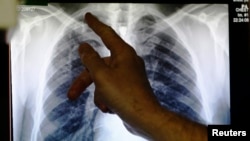Scientists are developing an antibiotic from a microorganism found in soil to fight the tuberculosis bacterium. As TB becomes increasingly resistant to existing antibiotics, soil could hold the key to new drugs against this global killer.
Tuberculosis is treatable with antibiotics, but in thousands of cases, antibiotic misuse has caused the disease to become non-responsive to the drugs.
According to the World Health Organization, there are 10.4 million new cases of tuberculosis every year, killing 1.8 million people.
In 2015, it was estimated that 480,000 infections were not responsive to two major drugs commonly used to treat TB. A quarter-million patients died reportedly of drug-resistant infections.
An international team of researchers has been hunting for new sources of antibiotics in nature to treat deadly illnesses like TB.
Investigators have hit upon a species of bacteria in a large family called Streptomyces found in soil.
Making synthetic compounds
In the laboratory, they’ve extracted compounds from Streptomyces that target a specific enzyme called MraY in mycobacterium, the pathogen that causes TB. The compounds effectively kill mycobacterium.
Using synthetic chemistry, the researchers were able to recreate these compounds, turning them into more potent versions of the originals.
Structural biology professor David Roper of England's University of Warwick is part of the team that includes scientists in the United States and Australia sleuthing for novel agents to treat disease.
In the case of the Streptomyces microorganism, Roper said researchers have extracted compounds that target how mycobacterium makes its cell walls. He likens them to bones in the human body.
“If you knock out our skeletons, you’re not going to be a very competent human being, are you? And the same is true for the biosynthesis of the bacterial cell wall. It’s exactly the same principle that penicillin inhibits, although that’s a different enzyme and other antibiotics like vancomycin for example. So, the biosynthesis of the bacterial cell wall is a good target for antibiotics,” said Roper.
Finding the right tools
The work was published in the journal Nature Communications.
In the soil, Roper said the bacteria use the compounds to kill other microorganisms near them, giving them a survival advantage.
“One of the reasons for looking at natural product compounds in general is that these things have been derived from nature, therefore they’ve gone through many millennia years of evolution in the first place, and they’ve been retained by nature so they must have, as it were, long-standing efficacy.”
The challenge has been growing soil bacteria like Streptomyces in the lab with available tools so they can be made into drugs. The team is looking for ways to do that and they are beginning to find the right tools.
There is no timetable for turning soil bacteria into drugs against diseases like TB, just that it will take time.
As new drugs from soil bacteria become available, Roper doesn’t rule out the possibility that TB eventually may become resistant to them too.
Researchers, however, have learned from experience with tuberculosis that antibiotics must be used with great care to preserve their effectiveness.






